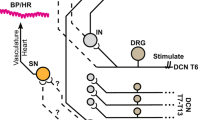Summary
Thermal stimuli applied to roughly one half of the body skin in anesthetized and paralyzed rabbits evoked antagonistic changes of regional sympathetic activity. Peripheral cooling resulted in an increase of cutaneous sympathetic activity, while visceral sympathetic activity decreased. Peripheral heating induced a decrease of cutaneous sympathetic activity and simultaneously an increase of visceral sympathetic activity. The same antagonism has been found during central nervous thermal stimulation at different levels. This identity of vasomotor patterns reveals that qualitative differentiation of regional outflow represents a typical thermoregulatory response of the sympathetic system.
Similar content being viewed by others
References
Grayson, J.: Vascular reactions in the human intestine. J. Physiol. (Lond.)109, 439–447 (1949).
Iriki, M., Riedel, W., Simon, E.: Regional differentiation of sympathetic activity during hypothalamic heating and cooling in anesthetized rabbits. Pflügers Arch.328, 320–331 (1971).
Kullmann, R., Schönung, W., Simon, E.: Antagonistic changes of blood flow and sympathetic activity in different vascular beds following central thermal stimulation. I. Blood flow in skin, muscle and intestine during spinal cord heating and cooling in anesthetized dogs. Pflügers Arch.319, 146–161 (1970).
Kuntz, A.: Anatomic and physiologic properties of cutaneo-visceral vasomotor reflex arcs. J. Neurophysiol.8, 421–429 (1945).
Pickering, G. W.: The vasomotor regulation of heat loss from the human skin in relation to external temperature. Heart16, 115–135 (1933).
Rein, H., Rößler, R.: Die Abhängigkeit der vasomotorischen Blutdruckregulation bei akuten Blutverlusten von den thermoregulatorischen Blutverschiebungen im Gesamtkreislaufe. Z. Biol.89, 237–248 (1930).
Richins, C. A., Brizzee, K.: Effect of localized cutaneous stimulation on circulation in duodenal arterioles and capillary beds. J. Neurophysiol.12, 131–136 (1949).
Schönung, W., Wagner, H., Jessen, C., Simon, E.: Differentiation of cutaneous and intestinal blood flow during hypothalamic heating and cooling in anesthetized dogs. Pflügers Arch.328, 145–154 (1971).
Walther, O.-E., Iriki, M., Simon, E.: Antagonistic changes of blood flow and sympathetic activity in different vascular beds following central thermal stimulation. II. Cutaneous and visceral sympathetic activity during spinal cord heating and cooling in anesthetized rabbits and cats. Pflügers Arch.319, 162–184 (1970)
Wernøe, Th. B.: Viscero-cutane Reflexe. Pflügers Arch. ges. Physiol.210, 1–34 (1925).
Author information
Authors and Affiliations
Rights and permissions
About this article
Cite this article
Riedel, W., Iriki, M. & Simon, E. Regional differentiation of sympathetic activity during peripheral heating and cooling in anesthetized rabbits. Pflugers Arch. 332, 239–247 (1972). https://doi.org/10.1007/BF00587451
Received:
Issue Date:
DOI: https://doi.org/10.1007/BF00587451




